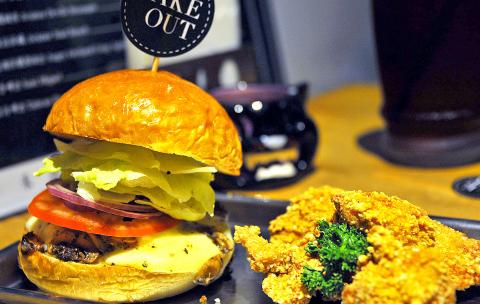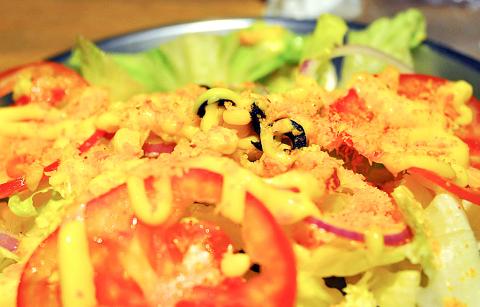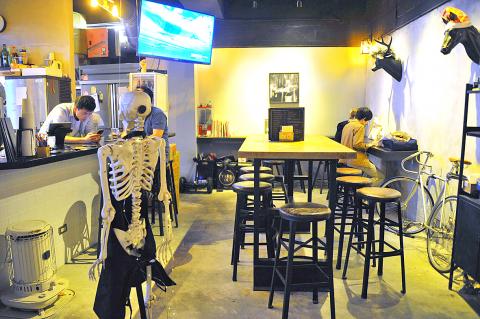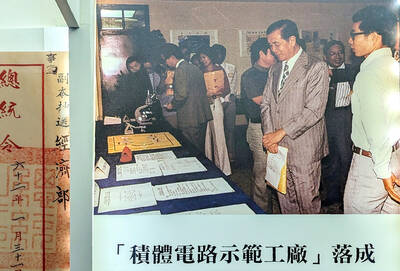The first thing I did when I walked into Take Out Burger, a small bar-style joint in the Liuzhangli (六張犁) area, was to try and figure out the decorations in the otherwise industrial-chic space.
Visitors are greeted by a skeleton in a black dress standing in the middle of the stone floor (staff says they change its outfit every now and then), and there are black horse and deer busts on the wall, one wearing a Santa hat with Chinese-style patterns and the other a silver wig. The garbage area is guarded by a large Moai statue, its stern presence reminding you to put the recyclables in the right bin.
It’s curious why this place is called Take Out — burgers and fried food are best eaten in the store, otherwise they get cold and soggy. Anyhow, the menu is eclectic, but not as offbeat as the decor. While the featured burger is an intriguing sweet Tianjin chestnut cream cheese creation (NT$200), the rest of the burgers are pretty tame, including spicy Mexican (NT$200), onion ring spicy meat sauce (NT$220) and the ubiquitous peanut butter burger (NT$180).

Photo: Han Cheung, Taipei Times
The store seems to rotate the featured burger monthly, and I’m glad I didn’t come last month because it was laden with parsley (which I personally abhor). They also have a wonderful selection of craft beer including Brooklyn, North Coast and local brewery Alechemist. There’s also Taiwan Beer for the less choosy.
I’ve fallen victim to novelty burgers before, but it’s still hard to resist ordering the sweet chestnut burger our of curiosity. To be fair to the restaurant, we also order the standard Mozzarella mushroom burger (NT$220). There are six sets — we choose B (NT$85) which comes with a drink and basil fried chicken, and E (NT$110) which comes with a drink and salad. Patrons can also add items a la carte to the burger and salad (between NT$20 and NT$60).
I’m biased against iceberg lettuce — it’s tasteless and watery — but it seems to be the the standard for side salads everywhere you go. It is topped with tomatoes, onions, corn, olives and what seems to be crumbled cheddar Doritos. I chose the mango dressing — which was too sweet as I had expected a little more tang. The dish overall was pretty pedestrian, although I enjoyed the Dorito toppings, which provided crunch, saltiness and a nice cheesy aftertaste to balance out the sweet dressing.

Photo: Han Cheung, Taipei Times
The sweetness overload continued with the chestnut burger as the cream cheese did not taste like cheese, but more like chestnut cream found on a cake. Coupled with the also sweet-leaning toasted brioche bun — which smelled pleasantly buttery and was crisp and firm on the outside — if felt like I was eating a dessert pastry instead. The generous handmade beef patty was excellent with just the right amount of juiciness and firmness, but its taste was overshadowed by the chestnut, which has strong overtones that linger on the palate.
The restaurant provides plastic gloves for those who don’t want to dirty their fingers — and trust me, you’ll need it for the chestnut burger.
This is why you never judge a restaurant by its novelty creations, because the Mozzarella burger was pretty enjoyable. It wasn’t anything special, but the flavors and textures made sense as a whole — and I could taste the bread and the meat for what they really were. Unfortunately, the patty was a little uneven, unlike the one in the chestnut burger. The mushrooms were the best feature — they were lightly seasoned (probably just pepper with a tiny dash of salt) and cooked just enough that they still retained firmness. Usually, mushrooms in burgers are softer and serve more as a complement, but these ones stood out, obvious in each bite.

Photo: Han Cheung, Taipei Times
Finally, there was the chicken — which, interestingly, tasted exactly like Taiwanese-style popcorn chicken (鹽酥雞), from the use of basil to the crunchy breading. Actually, it was much better than the stuff you get from the street, coming in larger pieces and the meat being much more succulent and juicy.
I probably should have tried one of their spicy meat sauce burgers, which many people have praised on the Internet. Maybe I’ll come back when they have another featured burger that catches my eye.

Photo: Han Cheung, Taipei Times

Oct. 27 to Nov. 2 Over a breakfast of soymilk and fried dough costing less than NT$400, seven officials and engineers agreed on a NT$400 million plan — unaware that it would mark the beginning of Taiwan’s semiconductor empire. It was a cold February morning in 1974. Gathered at the unassuming shop were Economics minister Sun Yun-hsuan (孫運璿), director-general of Transportation and Communications Kao Yu-shu (高玉樹), Industrial Technology Research Institute (ITRI) president Wang Chao-chen (王兆振), Telecommunications Laboratories director Kang Pao-huang (康寶煌), Executive Yuan secretary-general Fei Hua (費驊), director-general of Telecommunications Fang Hsien-chi (方賢齊) and Radio Corporation of America (RCA) Laboratories director Pan
The consensus on the Chinese Nationalist Party (KMT) chair race is that Cheng Li-wun (鄭麗文) ran a populist, ideological back-to-basics campaign and soundly defeated former Taipei mayor Hau Lung-bin (郝龍斌), the candidate backed by the big institutional players. Cheng tapped into a wave of popular enthusiasm within the KMT, while the institutional players’ get-out-the-vote abilities fell flat, suggesting their power has weakened significantly. Yet, a closer look at the race paints a more complicated picture, raising questions about some analysts’ conclusions, including my own. TURNOUT Here is a surprising statistic: Turnout was 130,678, or 39.46 percent of the 331,145 eligible party

President William Lai (賴清德) has championed Taiwan as an “AI Island” — an artificial intelligence (AI) hub powering the global tech economy. But without major shifts in talent, funding and strategic direction, this vision risks becoming a static fortress: indispensable, yet immobile and vulnerable. It’s time to reframe Taiwan’s ambition. Time to move from a resource-rich AI island to an AI Armada. Why change metaphors? Because choosing the right metaphor shapes both understanding and strategy. The “AI Island” frames our national ambition as a static fortress that, while valuable, is still vulnerable and reactive. Shifting our metaphor to an “AI Armada”

The classic warmth of a good old-fashioned izakaya beckons you in, all cozy nooks and dark wood finishes, as tables order a third round and waiters sling tapas-sized bites and assorted — sometimes unidentifiable — skewered meats. But there’s a romantic hush about this Ximending (西門町) hotspot, with cocktails savored, plating elegant and never rushed and daters and diners lit by candlelight and chandelier. Each chair is mismatched and the assorted tables appear to be the fanciest picks from a nearby flea market. A naked sewing mannequin stands in a dimly lit corner, adorned with antique mirrors and draped foliage